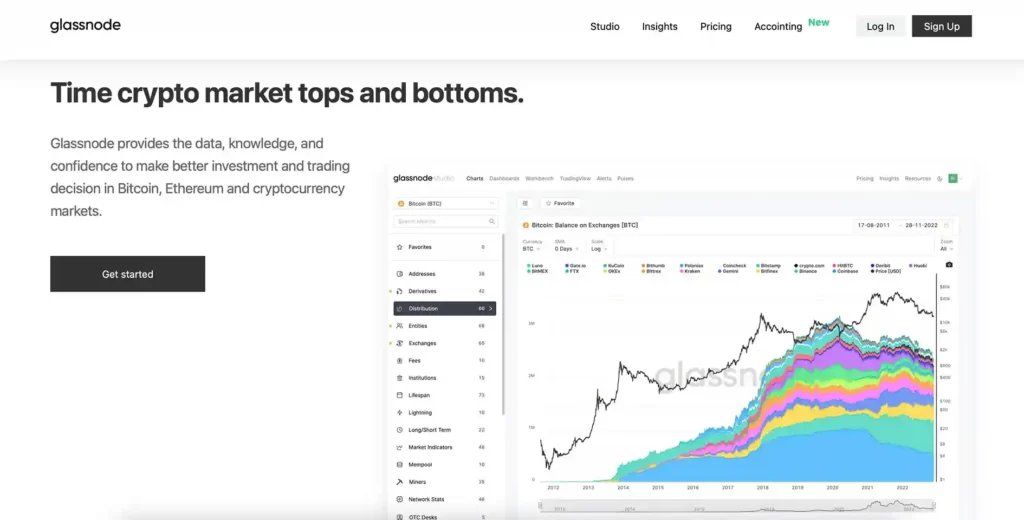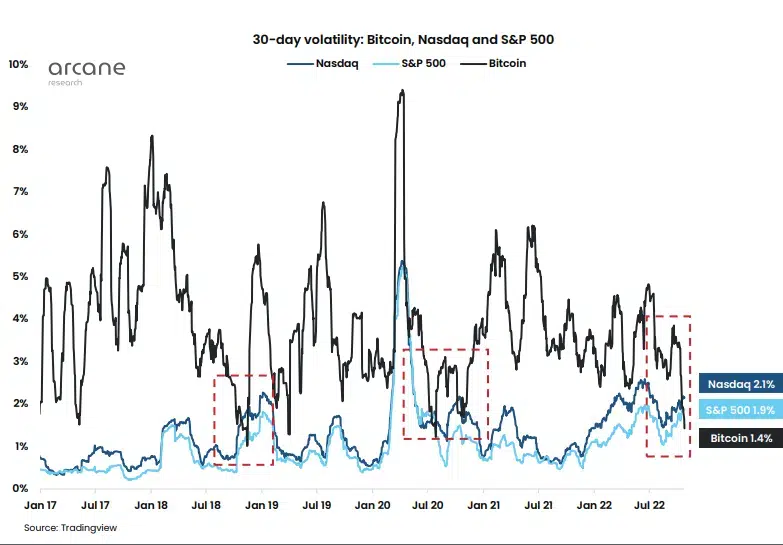Financial markets give buyers and sellers an avenue to trade financial assets. Investor participation in established markets like the stock market and emerging ones like the cryptocurrency markets has increased over the past decade. This is due to the proliferation and popularity of online marketplaces and mobile investing apps.
- Similarities Between Cryptocurrency and Stock Markets
- Retail Trading Platforms
- Technical Analysis and Indicator Tools
- Bull and Bear Markets
- Impact of Macroeconomic Events and Global Trends
- The Key Differences Between the Stock and Cryptocurrency Markets
- Asset Ownership
- Market Access and Trading Hours
- Transparency and Regulation
- Market Volatility
- Trading Pairs
- Liquidity
- Conclusion
While cryptocurrencies and traditional stocks are investment vehicles, they operate in vastly different markets. Both marketplaces share similarities. However, there are important factors, from market access to volatility, which indicate that each has unique characteristics and distinctions.
Similarities Between Cryptocurrency and Stock Markets
Before addressing the differences between the two marketplaces, it is wise to acknowledge their similarities.
Retail Trading Platforms
Most retail investors interact with the cryptocurrency markets and stock markets via digital exchanges, brokerage accounts, mobile applications, or other online platforms. Most online platforms and services provide a comparable user experience for both of these assets. It is important to note that in the crypto sphere, while most centralized exchanges (CEXes) offer traditional order types, the functionality of most decentralized exchanges (DEXes) is limited to market orders.
Technical Analysis and Indicator Tools
Technical analysis is a technique used to assess financial assets by reviewing market activity statistics, such as previous prices and volume, to identify trends and patterns, and predict future price movements. Some common technical indicator tools used in both stock and crypto markets include Moving Averages (MA), Relative Strength Index (RSI), Bollinger Bands, and Fibonacci retracements. Furthermore, TradingView, the financial market data platform, is a popular choice among traders and investors from both marketplaces.
Bull and Bear Markets
The stock and cryptocurrency markets frequently use the terms bull and bear markets. Although the degree of volatility varies, these markets tend to follow cycles with long periods of declining asset prices and upward trajectories. Therefore, both markets require a level of risk management and diversification in investment strategies to minimize losses and maximize returns.
This guide provides a comprehensive understanding of crypto bull and bear markets
Impact of Macroeconomic Events and Global Trends
Both markets are affected and influenced by macroeconomic events and global trends. For instance, changes in interest rates, GDP growth, inflation, wars, and pandemics impact both markets. Political events such as elections and government policies also affect the markets.
The Key Differences Between the Stock and Cryptocurrency Markets
Asset Ownership
The type of assets investors choose to invest in is the most crucial distinction between the emerging cryptocurrency market and the established stock market. As the names indicate, while cryptocurrency trades on crypto markets, companies’ stocks and shares are bought and sold on stock markets or exchanges.
Shares of stock traded on the stock exchange represent a portion of equity or ownership in the company issuing the stock. While some cryptocurrency security tokens function similarly to stocks, representing an equity stake in an issuing company, most crypto assets do not represent partial ownership of any issuing company. Other crypto assets like Bitcoin are viewed as digital commodities or as a store of value like gold. Therefore the utility of cryptocurrencies varies widely from one project to another.
Additionally, unlike stocks, cryptocurrencies frequently do not have central banks or other central authoritative bodies that issue or regulate transactions or assets. Instead, cryptocurrencies are decentralized digital assets that use blockchain technology to record transactions and secure ownership. The decentralized nature of these assets allows investors and users to have complete custody and ownership by moving their assets from CEXes to their private non-custodial crypto wallets or by using DEXes.
Market Access and Trading Hours
The stock market and the cryptocurrency markets have some differences in terms of market access and trading hours. There are set operating hours in traditional stock markets around the world. Stock markets typically open for trading Monday through Friday during regular business hours. For instance, the NYSE and NASDAQ stock exchanges in the United States open at 9:30 AM, and trading closes at 4:00 PM EST. Additionally, stock exchanges are closed on national holidays. This implies that only during these working days and hours may investors purchase and sell stocks.
However, the cryptocurrency market is open around-the-clock and operates on a global scale. In other words, investors can buy and sell cryptocurrencies anytime, regardless of whether it is during regular business hours. Therefore, due to the decentralized and 24/7 nature of cryptocurrency markets, geopolitical events in other regions could affect crypto prices to fluctuate at any time of the day. As a result, it is even more critical to keep up with macroeconomic developments in other nations that could influence the cryptocurrency market.
Imagine if the stock market was open 24/7 and investors had the benefit of reacting to news in real time, rather than having to wait until the market opens, which massively amplifies the volatility and emotion.
Crypto moves first because the market is open.
— The Wolf Of All Streets (@scottmelker) February 24, 2022Transparency and Regulation
The stock market and the crypto market have significant differences in terms of regulation. Traditional stock markets across the globe are heavily regulated by government bodies such as the Securities and Exchange Commission (SEC) in the United States, the Financial Conduct Authority (FCA) in the United Kingdom, and similar agencies in other countries. These regulations protect investors from fraud and other forms of financial misconduct.
On the other hand, the novice cryptocurrency market remains largely unregulated. Therefore, there are currently inadequate safeguards in place to protect investors from fraud. Some nations, like the United States, have started to enact regulations, while others, like Japan, are approaching cryptocurrency regulation with more progressive policies. Many countries, though, still need a detailed regulatory framework for cryptocurrencies. The regulatory landscape in the crypto market is constantly evolving. For instance, despite new taxation laws, regulatory oversight still needs to be clarified in India, where the number of cryptocurrency users increased from 8% to 21% between 2018/19 and 2021/22, according to a Statista report.
Regulators also help ensure that companies issuing stocks give investors transparent and up-to-date financial information. These take the form of yearly reports and quarterly financial updates. Before investing, investors perform fundamental analysis on stocks using data such as price-to-earnings (PE), price-to-book (PB), and earnings per share (EPS), among many other fundamental indicators.
In crypto, however, company revenues, profits, and expenses are nonexistent. Investors gauge the transparency and potential of cryptocurrencies by using tools and indicators unique to the crypto world. This includes reviewing crypto projects’ whitepapers, analyzing tokenomics, and accessing transparent blockchain data like wallet balances, transaction volumes, active addresses, etc., to assess sentiment. This is done using on-chain analytics resources like Glassnode.

Market Volatility
While both markets are susceptible to volatility, the crypto market is typically more unpredictable and turbulent. Due to their long history, large market, and regulatory oversight, price fluctuations in the stock market are less pronounced. On the other hand, there is higher volatility in crypto due to the relatively new and small cryptocurrency market, new investor profile, and ambiguous regulations.
Read this guide for a more in-depth understanding of the factors influencing crypto volatility.
Volatility offers the potential for both extremely high returns and the possibility of catastrophic losses. As a result, cryptocurrency markets are renowned for being much riskier and more lucrative than their traditional stock counterparts. Having said that, some assets in the cryptocurrency market, such as bitcoin, the largest and oldest cryptocurrency, display signs of decreased volatility, which point to the market’s maturation.

Trading Pairs
The quantity and diversity of trading pairs are another inherent difference between the stock and cryptocurrency markets. Stocks trade against the local fiat currency, such as the US dollar. While it is possible to trade cryptocurrencies for fiat currency on some centralized exchanges, there are also crypto-to-crypto trading pairs available on the market, such as Bitcoin/Ethereum. The number of trading pairs varies across each exchange depending on the variety of cryptocurrencies supported. For instance, Coingecko reports that Binance, the largest centralized exchange in the cryptocurrency market, offers 1393 trading pairs among the supported 354 crypto assets.
Liquidity
Liquidity is the ease with which an asset can be bought and sold without affecting its market value. Due to the high volume of active traders and institutional investors, stock markets are frequently regarded as highly liquid. That said, there are liquidity issues when trading penny stocks or micro-cap companies on the stock market.
Liquidity in cryptocurrency markets varies significantly from one cryptocurrency to another. For instance, the fact that Bitcoin sees more trading volume than most crypto assets makes it more liquid. When trading low-cap altcoins or buying and selling on smaller crypto platforms, investors may experience low liquidity. When there is minimal liquidity, it may be more challenging to buy and sell large quantities of a cryptocurrency without seriously impacting its market price, which results in higher price volatility. This is why low-cap crypto assets have the potential for enormous returns and losses.
Conclusion
The cryptocurrency market is an evolving and unique space that differs significantly from traditional stock markets in several ways. Both markets have their own set of characteristics, advantages, and limitations. Understanding the differences in how the cryptocurrency market functions are crucial for investors moving from the conventional financial realm to the cryptosphere. As always, before investing in any market, whether it be stocks or cryptocurrencies, it is crucial to conduct careful research and understand the risks involved.




















